Keith and Kate from Bountiful Backyards came back to help us today. We were very excited to GET STUFF IN THE GROUND!!
The first thing we did was fill two wheelbarrows with water, and add some super juice to feed the plants. This eases the transplant shock by giving the roots a big growing boost. You can soak the plants for up to a full day, if they look like they need it. The one we used was made of kelp.
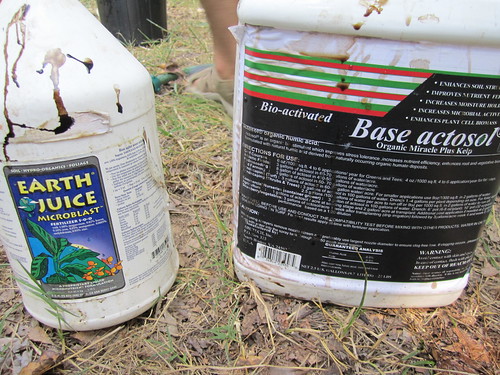
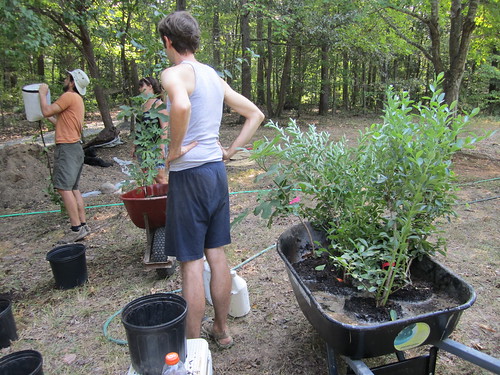
Then we made a soil amendment mix. Gypsum is a mineral, the same they use in sheet rock. Two handfuls per tree will help break up that NC clay and turn it into nice top soil quicker. The remaining mix was bonemeal, green sand (potassium), lime, and kelp meal. The mix was about 3 parts gypsum, 1 part everything else. Phosphate (orange bag in photo) and mycorrhizal inoculant (mushroom spores!) were also used on each plant, but not mixed in to the bucket pictured, with the rest. You need about one TINY pinch of inoculant per plant, and a varying amount of phosphate per plant.

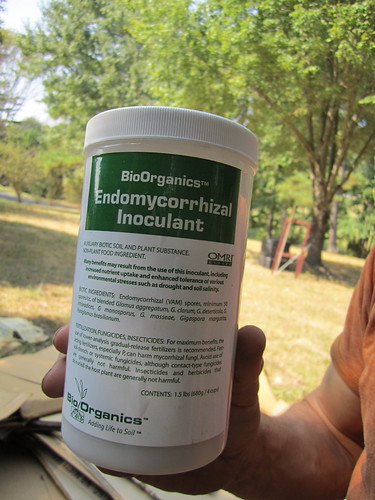
We then went to the pear tree holes, and sprinkled in 5 handfuls of soil amendment mix (see bucket) and phosphate (see orange bag).
Then Ash mixed in native soil while Kate dumped in purchased top soil, and Keith stirred it all together. Then we added another handful of soil amendment mix.
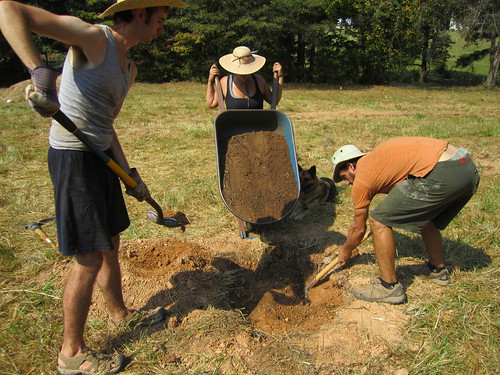

After soaking strips of newspaper (soy based ink only!!) in the plant juice, we placed that in the hole as well. This is for the inoculant. If you look closely, you can see that we made a tiny dirt ridge in the center of the hole. This is called "butterflying" so we can separate the roots of the potted plant on each side of that ridge. You can see Kate and Keith showing us how to gently separate the roots of the asian pear tree in the photo.
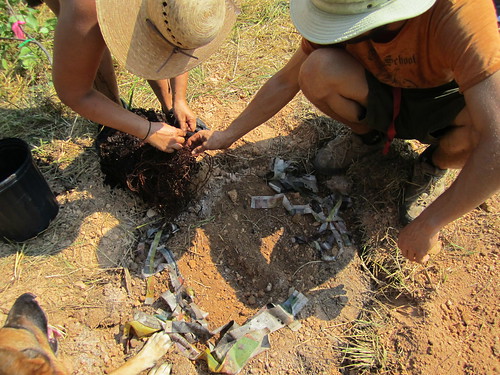
Then, we added more purchased top soil and a little more native soil. Keith gently stepped in the soil to press the tree into it's new home.
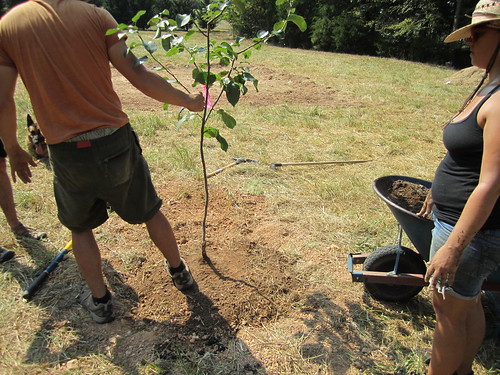
We then sprinkled on more soil amendment mix, and Keith formed a ridge on the downhill side of the plant, to help the tree collect and hold water better.

Then we planted our asian pear tree a bunch of friends!! These are called support plants.
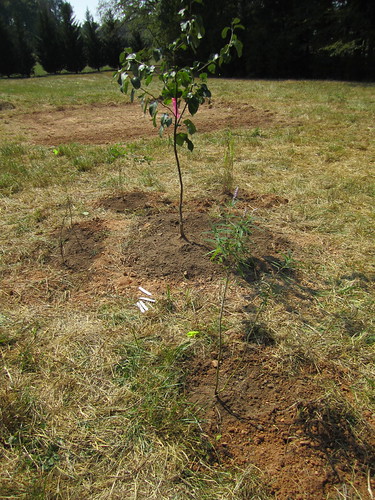
Lupine brings nitrogen from the air into the soil. When you cut the plant in early spring, this signals the roots to release the nitrogen into the soil, fertilizing your tree. You can bury the cuttings under the mulch for further nutrition for your tree.
Yarrow was planted for a ground cover. It will spread as we cut and transplant it. It also accumulates calcium in it's leaves, and pear trees love calcium!! Deer don't like the smell of it, but pollinators are attracted to it. It is also medicinal for humans. What a plant!!
Bush Sage was planted because it smells strongly, which deer don't like. It also has nice flowers to attract pollinators, and is very pretty to look at.
Bronze Fennel- somehow I am missing my notes on this plant...
Shenendoah Switch Grass makes noise at the slightest breeze, and deer do not like to be surprised by rustly noises. If you want you can cut every few months and place that under the mulch as well.
Comfrey will be planted as soon as it comes in to the store next month. Comfrey is a great nitrogen fixer and it spreads really well for ground cover. You can also bury these leaves under the mulch near your tree for nitrogen.
We then covered the ground in soaked newspapers, being sure to cover every gap of soil. This saves you a lot of weeding work later. Especially because we put a layer of soaked cardboard on top of the newspaper layer!!

Then... we put a layer of mulch. DONE!!
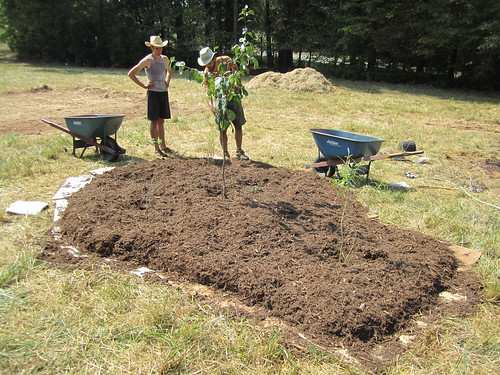
On the other pear tree, we did a different technique for planting support plants. We made trenches radiating out from the tree, which you can see in this photo. The trenches will be filled with nitrogen fixing cover crop (probably red clover).

Then Kate and I worked on the figs. Remember we dug one big long trench for the figs. Keith and Ash worked on the blueberry bush. We did not dig a hole for the blueberry bush. They scrapped the grass off with a hoe, and then used a pick-axe to break up the soil on the surface. They built the bed UP for the blueberry bush, using a lot of purchased top soil, potting soil, and soil amendments. The blueberries have this little ridge surrounding them for water retainment. Then we again soaked newspaper for the blueberry. The figs do not have newspaper or mulch yet, because we have to plant clover and wildflowers in the trench between the fig trees. The planting of the figs used the same technique as the pear trees, only they didn't need as much phosphorus. You can see around the blueberry bush that we are laying out more support plants. I don't have any info on those plants yet.
Blueberry:

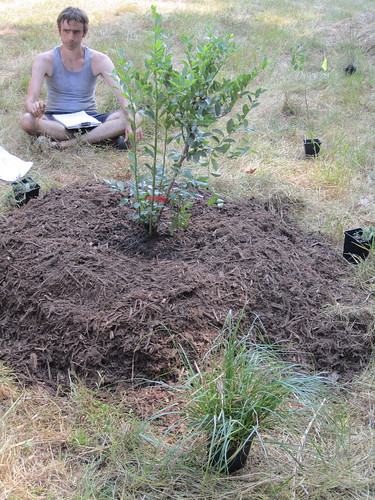
Figs:
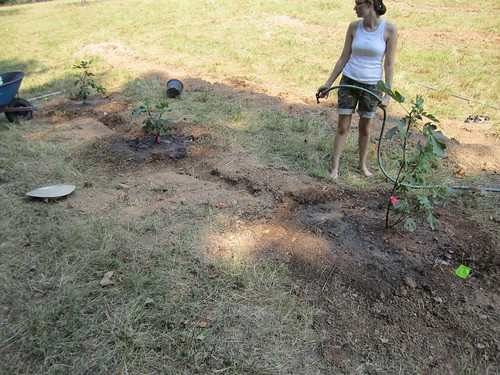

No comments:
Post a Comment